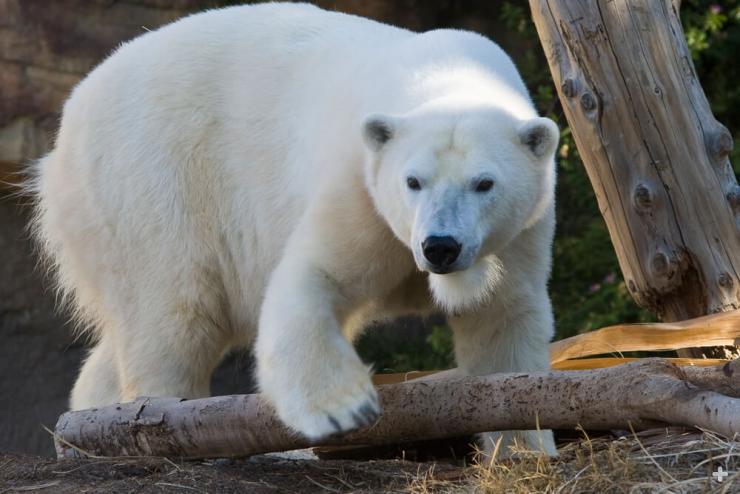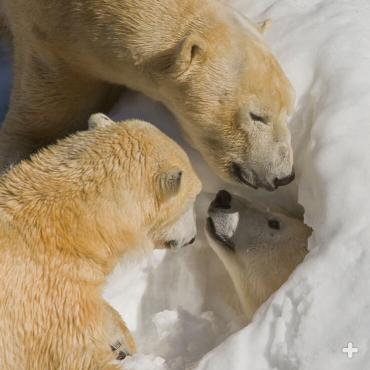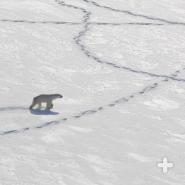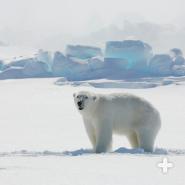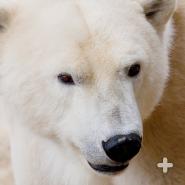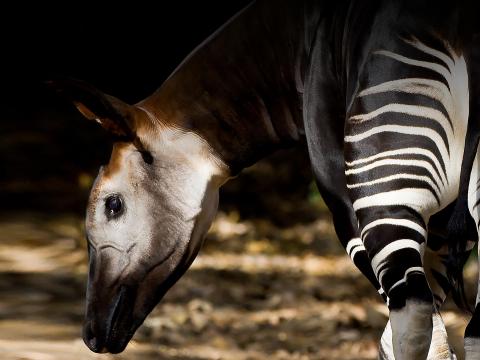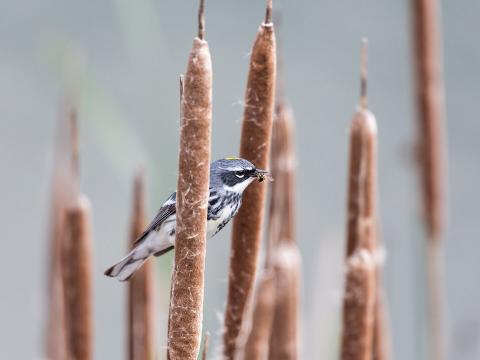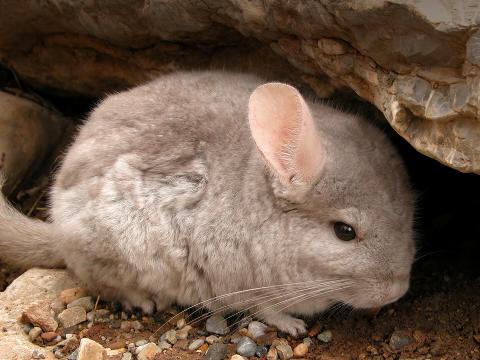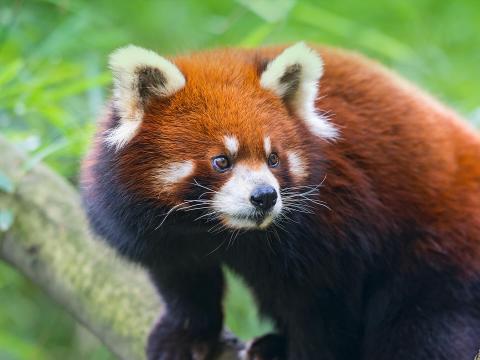Polar Bear
- CLASS: Mammalia (Mammals)
- ORDER: Carnivora
- FAMILY: Ursidae
- GENUS: Ursus
- SPECIES: maritimus
ABOUT
Baby, it's cold outside! Perhaps no other wildlife symbolizes the frozen tundra regions of the Earth as do polar bears. They live on ice and snow, but that’s not a problem—these bears have some cool ways to stay warm!
An outer coat of long guard hairs that stick together when wet protects a dense, thick undercoat of fur. On land, water rolls right off of the guard hairs. Even though polar bears look white, their hair is really made of clear, hollow tubes filled with air. Scarring or residue on the fur can cause the “white” fur to appear to human eyes as cream colored, yellow, or even pink in the Arctic light.
Fat acts as a nutritional reserve and energy storage when food can’t be found, and may provide the ability to generate heat to help insulate polar bears from the freezing air and cold water. This fat may also help the bears float in the water. It is 2 to 4 inches (5 to 10 centimeters) thick.
Unlike brown bears and black bears, polar bears do not hibernate, and only pregnant females over-winter in dens. While in the den, the pregnant female’s activity level decreases and her metabolism slows down. During this period, she gives birth and nurses her cubs. Sometimes, when weather conditions are particularly rough, other bears may dig temporary shelters, where they spend several days at a time.
The polar bear is the newest of the eight bear species, and scientists believe that the polar bear evolved about 200,000 years ago from brown bear ancestors. Both polar bears and brown bears are big and are the largest land carnivores. But most experts agree that polar bears are the longest bears, as males may measure over 10 feet (3 meters) when standing on their hind legs.
Small bumps on the pads of a polar bear’s large, wide paws may add traction and help the bear walk on slippery ice. Polar bears spend their days hunting and sleeping after a good meal. For some, these meals need to last them during the upcoming months when the Arctic ice has melted, and they are forced to spend their days on land waiting for the fall cold to once again form the very important ice.
When not hunting, polar bears are resting, perhaps as much as 20 hours a day. Polar bears are great bed makers, building nest-like beds in seaweed piled up on the coast, digging deep caves of snow into the bluffs, or resting in a shallow snow bed and letting the blowing snow cover them, making for a snug day den.
HABITAT AND DIET
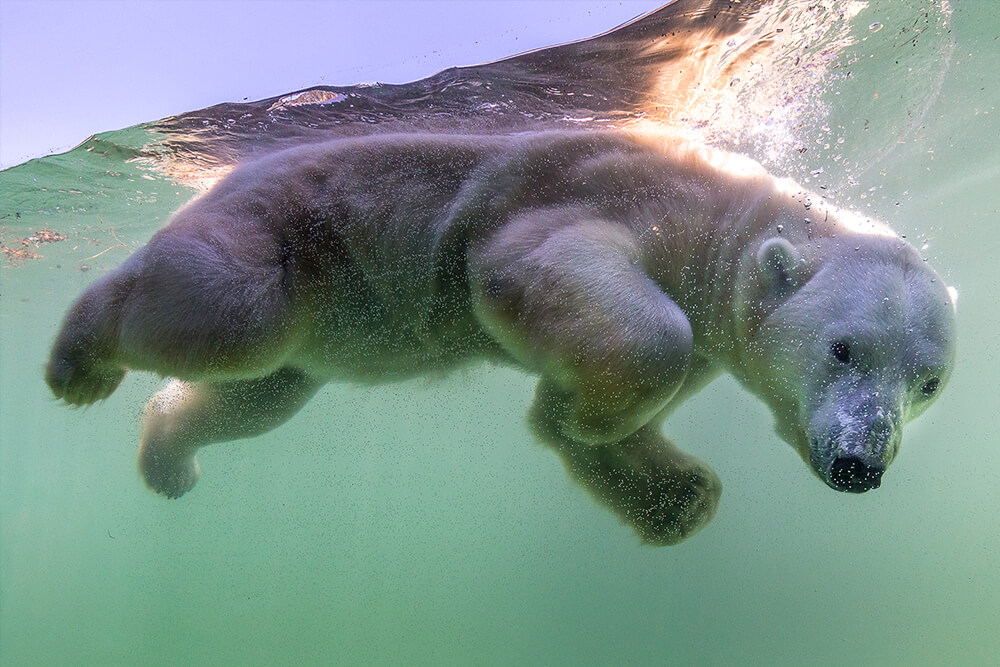
Polar bears live throughout the Arctic, in areas where they can hunt seals in wide cracks in the sea ice or at breathing holes. The taxonomic name for polar bears is Ursus maritimus, which means sea bear, a fitting name for these champion swimmers. They have been known to swim more than 60 miles (about 100 kilometers) without rest in search of food, using their broad front feet for paddling and their back legs like rudders to steer. Unfortunately, due to loss of ice, the bears are now having to swim longer distances, as much as a few hundred miles, which takes a toll on their energy and fat storage.
Despite the long, harsh winter, polar bears don’t hibernate. In fact, most of them (except pregnant females) continue to hunt seals throughout the winter. When the weather is extremely cold, and hunting is impossible, bears may seek temporary shelter in snow dens until conditions improve.
A pregnant female stays in a snow den throughout her pregnancy, the birth of her cubs, and the first few months of the cubs’ life, without leaving the den. Changes in her metabolism allow her to go without food, water, defecation, or urination for as long as eight months. For most mammals, fasting during pregnancy would be life threatening, but the female bear gains a massive amount of weight before she dens. Her stored fat reserves provide all the energy she needs to sustain herself and her cubs. Still, she wakes easily. This process is called winter sleep.
Polar bears have no natural enemies. Strong, ferocious, intelligent, and patient hunters, they top the food chain in the Arctic, where they dine primarily on seals. The bears can remain motionless for hours above a seal's breathing hole in the ice, just waiting for a seal to pop up. The polar bear's nose is so powerful it can smell a seal on the ice 20 miles (32 kilometers) away, sniff out a seal's den that has been covered with snow, and even find a seal's air hole in the ice up to 1 mile (1.6 kilometers) away. No wonder many people call them "noses with legs!"
Polar bears can see well underwater, spotting potential meals 15 feet (4.6 meters) away. They have a nictitating membrane, or third eyelid, that allows them to see underwater and protects their eyes in blowing snow.
Stiff fur on the sole of each foot keeps the bear from slipping on the ice. It also muffles the sound of the bear’s approach when sneaking up on a sleeping seal. It costs a polar bear twice as much energy as most other mammals to move about in its Arctic environment. This helps explain their preference for resting frequently and hunting for seals using ambush techniques rather than stalking their prey.
The ringed seal is the polar bear’s main prey, as it is the most numerous seal in the Arctic. One ringed seal provides a polar bear with enough energy for 11 days. Polar bears typically kill and eat every four to five days. These bears eat just about anything, if they have the opportunity, but it is important to remember that they need access to the high-calorie diet that seals provide. While they will eat walrus, caribou, beached whales, grass, and seaweed, none of these have been shown to provide adequate and reliable nutrition for polar bears.
Polar bears at the San Diego Zoo get a fortified meat-based commercial carnivore diet, dog kibble, trout and other fish, as well as root vegetables and lettuce as treats. Cow femur bones and thawed rabbits are added once or twice per week. Polar bears get very little nutrition or calories from vegetables, so these items are offered as treats, and the whole carrots keep their teeth clean.
FAMILY LIFE
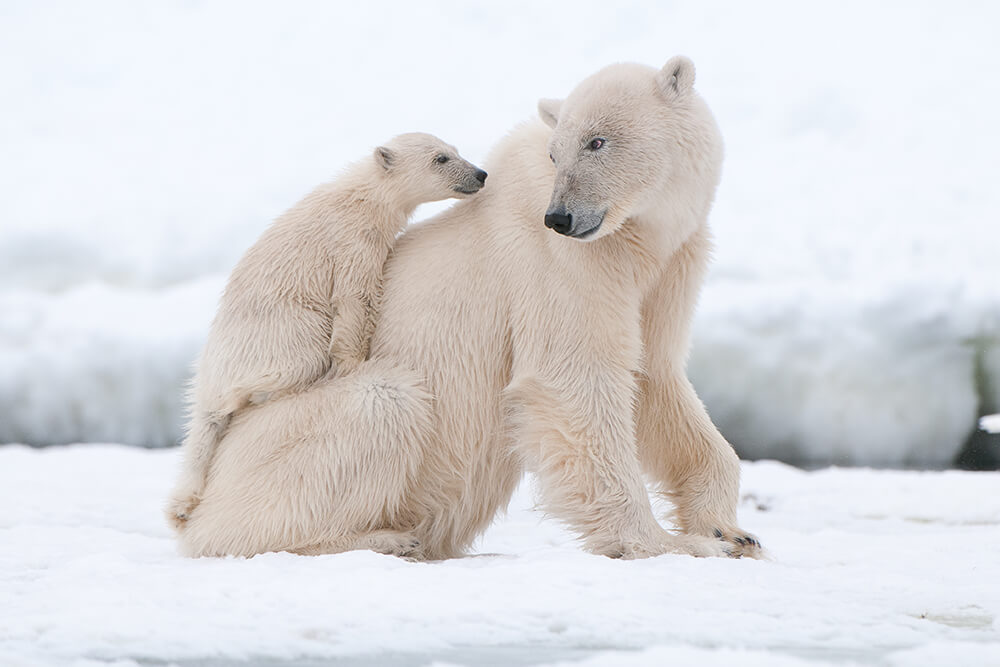
Polar bears are highly intelligent and playful. Two or more bears sometimes form “friendships” that last for weeks or even years. These bears wrestle as a form of play and may also feed and travel together. Individual polar bears have been observed sliding repeatedly downhill or across ice for no apparent reason other than just for the fun of it!
Polar bears are fairly quiet. Females and cubs in the den make a pulsating hum. These calls are most frequent in a cub’s first few months. Young bears also make a chuffing call to each other, which is infrequent in adult bears.
Except for females with cubs, polar bears are solitary. Sometimes several bears scavenge together at a whale carcass or human garbage dump. Dominance is based on size, but for the most part, each individual behaves independently. Polar bears have large, overlapping home ranges and are faithful to general geographic regions, but they don’t defend territories.
Each spring, beginning in about March, adult males begin to search for mates. Incredible as it may seem, conservation scientists suspect that males detect the scent of a female in the footprints she makes in the snow! Once a male finds a receptive female, the two bears remain together for about two weeks.
A fertilized polar bear egg doesn’t implant or develop right away. Instead, it implants when triggered by the female’s body condition and environmental factors, most often between September and November. This is known as delayed implantation, an adaptation that ensures cubs will be born to healthy mothers at a time of year when their chances for survival are greatest.
Breeding season for polar bears goes from about March to mid-July. A pregnant female digs a maternity den, usually into a snow bank, in October or November. The den is often no bigger than a telephone booth, but it can be about 40 degrees warmer in there. The female gives birth to one to three cubs, usually twins, in December or January.
For such a big animal, they sure start out small! Cubs weigh about 1 pound (0.45 kilograms) when born and are hairless and have their eyes closed at birth. They depend on the mother to keep them warm and fed. Milk from polar bear mothers is 36 percent fat, the richest milk of any bear species. This helps the cubs grow quickly, and by April, they weigh more than 20 pounds (9 kilograms) and start exploring with their mother outside the den. At about two years of age, they are ready to be on their own.
AT THE ZOO
When the San Diego Zoo received its first polar bear in the summer of 1917, the bear was displayed in a cage, as was typical of zoos of that era. A gift from Ellen Browning Scripps launched construction of some of the world’s first barless habitats, and by 1926, a new polar bear grotto was complete. The habitat’s revolutionary design offered amazed visitors close and unobstructed views of three polar bears.
Today, our polar bears live in a wonderful tundra habitat complex: the Conrad Prebys Polar Bear Plunge. The focal point of the Plunge is, naturally, the pool. From the underwater viewing room, you can see how agile and playful these Arctic bruins really are. In fact, they’re known to swim right up to the glass to check out all the humans on display. Outdoor viewing follows the water level up to the beach area, where two large pits filled with natural substrate and mulch allow the bears to dig around or take a nap—just like they would in the Arctic.
At the Experience Wall, wildlife care specialists open up the glass panels and interact with a polar bear through a mesh barrier as you stand just feet away. We’re thrilled to be able to offer this unique connection between humans and polar bears.
At Polar Bear Plunge, guests get a chance to explore the world of the polar bear through interactive elements. Four-D models of the Arctic ice from 1989 and 2007 show what’s happening to the polar bear’s habitat, and guests can check out our large carbon graph, which shows what recorded carbon dioxide levels have been historically and compares them to where they are today.
Our hope is that by exploring the polar bear, its lifestyle, and conservation challenges through the elements of Polar Bear Plunge, Zoo visitors will become more aware of the impact of their daily choices and empowered to make changes that will benefit them and wildlife around the world.
CONSERVATION

The polar bear is uniquely adapted to life on the sea ice of the Arctic Ocean, and for millennia they have roamed the vast and pristine circumpolar Arctic relatively undisturbed by human activities. However, climate change has created a conservation crisis for polar bears, and their persistence is jeopardized by record-breaking sea ice losses and increasing industrial-scale human activity. In areas where the sea ice melts completely, polar bears must move ashore in the summer. They may scavenge to avoid starving, or they may fast until ice forms again. In some places, these bears have learned to eat at garbage dumps. They could be injured or poisoned by trash, and it puts the bears in close contact with humans. This can be a dangerous situation for both humans and bears.
For nearly a decade, San Diego Zoo Wildlife Alliance's conservation scientists and our US and Canadian partners have focused on developing the best conservation strategies to boost their populations. Every detail matters: reproduction, denning, communication, available prey, formation of sea ice, climate change, and the impact of human activities are all evaluated.
We are helping the U.S. Geological Survey of Alaska by having one of our polar bears, Tatqiq, wear an accelerometer collar to track her movements. Measuring Tatqiq’s movements at the Zoo will provide a baseline by which to identify behaviors for bears wearing the accelerometer collars in the Arctic. The data gained from accelerometers on collared polar bears in the Arctic will provide U.S. Geological Survey scientists with new insights into the bears' daily behavior, movements and energy needs, and a better understanding of the effects of climate change on polar bears.
Today, it is estimated that there are 22,000 to 27,000 polar bears throughout the Arctic. Polar bears still need our help. People must continue to give these bears large, safe places to live and try to keep the environment clean and free of pesticides that could poison the bear's food. We believe an Arctic without polar bears is simply unthinkable!
By supporting San Diego Zoo Wildlife Alliance, you are our ally in saving and protecting wildlife around the globe.


